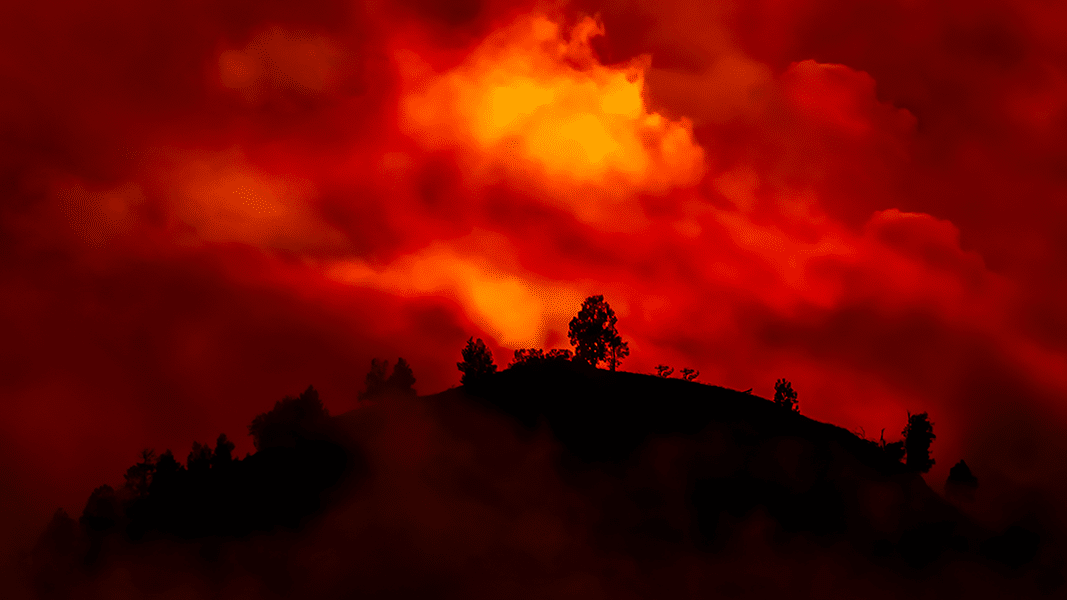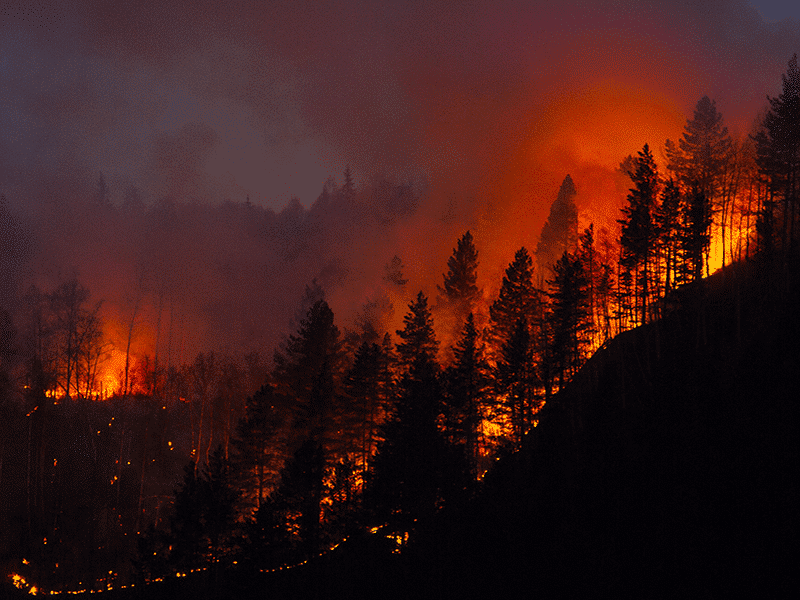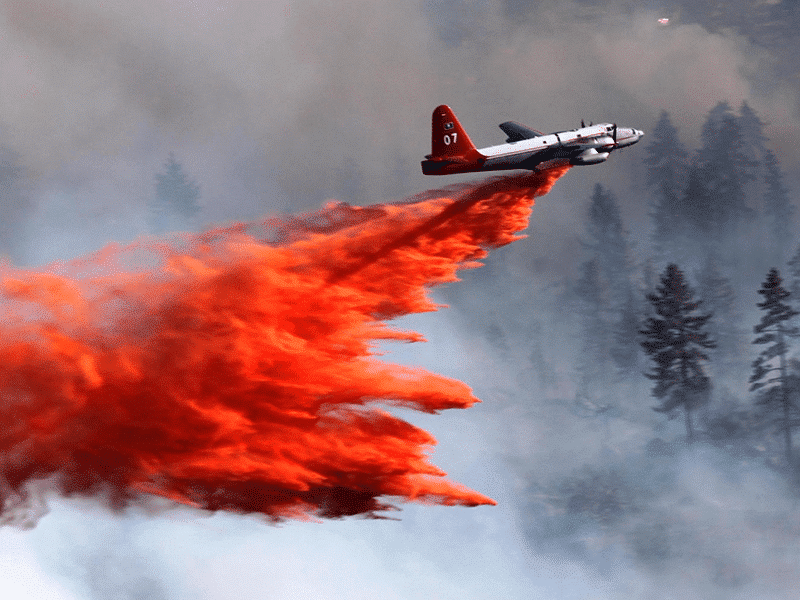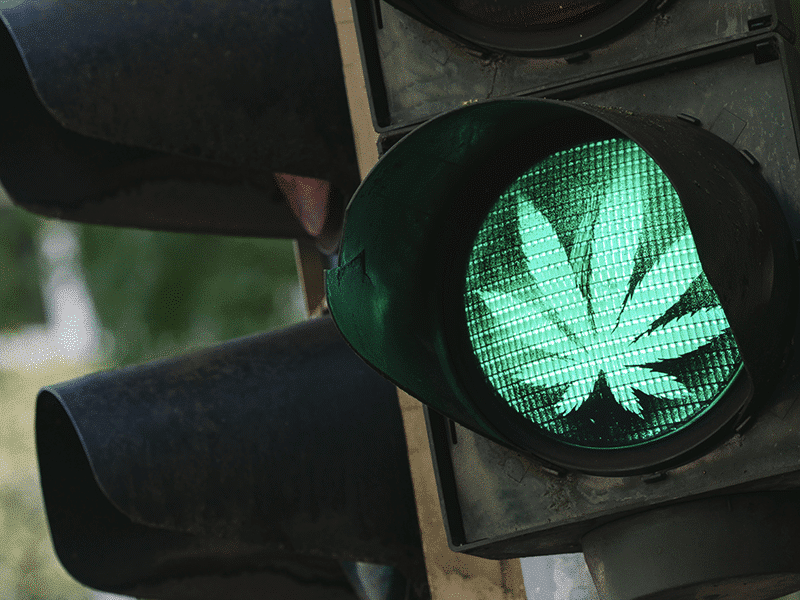The question of the root causes of the 2020 West Coast fires has become pathologically politicized. As with the pandemic and the efficacy of face masks, what should be a matter of objective science and public health has taken on a bitterly partisan tone.
This became especially evident when President Trump threatened to withhold approval of a disaster relief package for California before finally blinking and signing it in mid-October. Trump changed his mind after a visit to the state, where he was petitioned by Gov. Gavin Newsom and other officials. Trump insisted the fires were due to poor forest management, suggesting state officials were to blame.
Fact check: Nearly 60% of California’s forests are actually managed by the US Forest Service and other federal agencies, such as the Bureau of Land Management.
The secretary of California’s Natural Resources Agency, Wade Crowfoot, admonished the president that the wildfires could not be entirely blamed on forest management. “We want to work with you to really recognize the changing climate, and what it means to our forests,” Crowfoot said. “If we ignore that science, and sort of put our head in the sand, and think it’s all about vegetation management, we’re not going to succeed together protecting Californians.”
When Trump dismissively predicted that the climate would “start getting cooler,” Crowfoot replied, “I wish science agreed with you.” Trump shot back: “I don’t think science knows.” The response prompted jeers from environmentalists, and presidential contender Joe Biden labelled Trump a “climate arsonist.”
130 in Death Valley
There is little doubt that California’s climate is changing. On Sept. 22, 2020, the New York Times reported: “Last month, before the skies over San Francisco turned a surreal orange, Death Valley reached 130 degrees Fahrenheit, the highest temperature ever measured on the planet.”
As Cristian Proistosescu of the Atmospheric Sciences Department at the University of Illinois tweeted: “Don’t think of it as the warmest month of August in California in the last century. Think of it as one of the coolest months of August in California in the next century.”
The firestorms have only added to a depressing sense of inevitability. A July 2020 study in Nature found that “even fully removing anthropogenic emissions is unlikely to have a discernible impact before mid-century.”
On the other hand, columnist George Skelton asserted in the Los Angeles Times (Sept. 21, 2020) that the experience in the Sierra de San Pedro Mártir of Mexico’s Baja California state (starting about 75 miles south of the border) provides “proof that climate change is not the primary cause of horrific Western wildfires.”
He argued that until the 1970s fires started by lightning in this range were allowed to burn themselves out. “The result of nature’s management is a forest that’s practically in mint condition, resistant to fire and disease.”
In a 2003 wildfire that swept through the range, eighty percent of the trees survived.
Skelton quoted UC Berkeley fire science professor Scott Stephens, who has studied the Baja range for 20 years. “Every time I go down to that place it astounds me how well that area has been able to adapt to climate change,” Stephens said. “Climate change certainly has hit that place too. But it’s doing well.”
Wildfire Paradox
Forests need periodic fires to regenerate. Researcher Kimiko Barrett at the Montana-based firm Headwaters Economics calls this the “wildfire paradox.” He told National Public Radio: “For a century and more now we’ve been intentionally excluding wildfires from the landscape in the effort to protect homes and communities. And in doing so we are aggravating the problem into the future.”
There’s little doubt that the situation is also aggravated by climate change. In August, researchers at the Plumas National Forest in the northern Sierra Nevada were surprised to find that sticks and logs they’d gathered to assess fire risk had a moisture level of just 2 percent. This was the lowest moisture level ever recorded in 15 years of measurements at the research site. Two weeks later, the Plumas exploded into the North Complex fire, one of the largest and deadliest in California history, killing 15 people and consuming an area the size of Los Angeles.
“Around the state, we’re seeing record-low fuel moistures. It’s helping to drive a lot of the extreme fire behavior,” Craig Clements, director of the Fire Weather Research Laboratory at San Jose State University, told Environment & Energy News.
Some took issue with the media’s narrow focus on the scale of the fires. “Even within a single fire, we have to be able to distinguish between the good and the bad, and focusing on area burned doesn’t allow us to do that,” sad Crystal Kolden, a fire scientist at UC Merced, writing in Nature.
Kolden told NPR: “If you don’t allow fire to burn in those places regularly, you get a build-up of too many trees, too much shrubs in the understory, and that is what we have seen is driving a lot of these really large fires.”
While the 4 million acres lost across California in 2020 may seem like a staggering figure, scholars increasingly believe it’s on par with what typically burned in a year in the territory that now makes up the state for many centuries before European contact — when Native American peoples used fire to shape the landscape.
“We have not been adapting,” said Ernesto Alvarado of the Pacific Wildland Fire Sciences Laboratory in Seattle. “We will never be Native Americans, but we can be indigenous to the land. And one of the things we need to accept: this place burns. The West burns.”
Reviving “Cultural Burns”
To make sense of this, Project CBD turned to Don Hankins of the Chico State University Geography Department, who spoke to NPR over the summer about the traditional practice of “cultural burning” by California’s Native American peoples — and the lessons this custom may hold for the current crisis.
Hankins, an expert in the new field of “pyrogeography,” did his UC Davis dissertation on riparian use of fire by the Moklumne and other indigenous peoples in the Central Valley and Sierra Nevada foothills. He is himself of the Plains Miwok, a related people in the Sacramento-San Joaquin Delta area.
In addition to studying the history of “cultural burns,” he is also working to revive the practice at the Big Chico Creek Ecological Reserve and Butte Creek Ecological Preserve, both run by the state university. “We are doing prescribed burns in the chaparral, so I get to apply the knowledge I have in that landscape,” Hankins tells Project CBD, referring to California’s distinctive brushlands.
The nearby Mechoopda Indian Tribe of Chico Rancheria is also involved in these efforts. Bridging academics and Native American communities in this work is part of what Hankins calls “building synergies for promoting an indigenous stewardship across the state, that includes fire.”
The Dogma of Fire Suppression
Hankins traces the first policies against burning to a 1793 proclamation by the Spanish governor of what was then the New Spain province of Alta California. Under United States rule, the dogma of fire suppression began around 1910, but Native communities in remote areas continued to burn up until the 1930s. Says Hankins: “Tribal knowledge about burning was maintained in some places and in other places not, due to lack of land.”
By 1910, the Native population of California had plummeted due to a systematic campaign of extermination after the Gold Rush. Local governments actually placed bounties on Native American heads. Some early land barons of Yankee California like John Bidwell and Leland Stanford offered protection from bounty hunters — but in the form of indentured servitude on their holdings. This grim arrangement rapidly undid what Hankins calls a tradition of cultural burning going back many hundreds of years.
“Each ecosystem in California has made traditional use of fire and has resources related to fire that were used culturally,” says Hankins, who cites the work of Canadian scholar Henry T. Lewis, author of the 1974 study Patterns of Indian Burning in California. Lewis identified “73 reasons California Indians used fire — maintaining travel corridors, preparing soil for tobacco planting, removing bugs, harvesting sticks of willow and hazel for baskets. Fires gives slender, supple sticks for weaving. They set fires in rings to concentrate grasshoppers, and roasted them to be consumed. They burned at different times of year to produce those effects.”
And while Hankins believes such fires may have actually affected as many acres as were burned in 2020 or more, they were largely kept under control. “It’s a question of knowing your ecosystem and reading the landscape you’re burning in — where is a fire naturally going to go from the area where you’re setting it? Moisture is a break on fire spreading while wind carries fire, so knowing those conditions is knowing where fire is going to naturally go. People had to know this, because you didn’t have fire trucks back in the old days.”
Ecologically Sound Fires?
And, critically, the carbon emission levels from these traditional fires were considerably lower on a per-acre basis than in today’s wildfires. Hankins this year served as science advisor to an online presentation by the California Air Resources Board, entitled “California Wildfire Emission Estimates.” The presentation stressed that “fire models can represent historical conditions,” and that “1 acre burned then ≠ [does not equal] 1 acre burned now.”
The presentation referenced the work of the aforementioned Scott Stephens at Berkeley, who in a 2007 study estimated that before 1800 (when European settlement of California began in earnest) up to 12 million acres burned annually — but not in the massive and uncontrolled infernos that we see today. And while current carbon dioxide emissions per acre are estimated at a daunting 27 megatons, before 1800 they were placed at far more modest 7.5 megatons.
These figures were arrived at through an analysis of tree-rings and tree ages in surviving old-growth forests. This living record of when fires occurred in turn allowed an estimate of what the fuel load in the forests would have been at the time. Hankins believes that indigenous controlled burning cleared out the underbrush and areas of dense growth, while big trees survived. “Such practices maintained fuel densities at manageable levels. With the fire suppression beginning in 1910, you start getting fuel accumulation.”
Similarly, a 1996 study by the US Forest Service’s Sierra Nevada Ecosystem Project found a greater density of trees in the forests of yester-century. “If you look at photos of Yosemite Valley from 1860s,” Hankins notes, “you see more open woodlands, with the conifers spaced far apart. With the close canopy we see today, that changes the nature of fire.”
And the pre-1800 indigenous burns were spread out over the year, rather than concentrated in what today is referred to as the “fire season” in California, from August to October. “Routine maintenance of fire within the landscape minimized fuel load and related emissions,” Hankins says. “We have an accumulation of fuel load today that is being volatilized each year.”
Applying Indigenous Knowledge
But how can this knowledge be applied in the super-developed California of today?
Hankins, hoping to emulate the practices of pre-1800 times, actually calls for burning more acreage than was burned in 2020. “We’d need to burn 6 million acres annually going forward to maintain healthy ecosystems,” he says. But, again, these would be controlled burns, not the all-consuming voracious wildfires we saw in 2020. And they would be carried out with a sensitivity to place and the forest succession.
“Oak woodlands require frequent fires to maintain themselves — every two or three years,” says Hankins. “Otherwise it gets too dense and doesn’t allow photosynthesis. While in grassland spaces where oaks are trying to get established, they need 10 years or more without fire.”
But he acknowledges: “Many of those woodlands and grasslands are missing today, due to farmland and development.”
Urbanization, of course, has also had an impact on shaping the fires. “There are 40 times more people living in the state today than in 1800, and especially more people in the wildland-urban interface,” Hankins says. “So there’s been some shifting on where and when fires are taking place. When fires are started by powerlines or people flicking cigarettes out windows, it isn’t fires that are thought-out as the indigenous burning was. These ignitions nowadays are happening under conditions in which people are not paying attention.”
He notes the role of the Santa Ana winds in Southern California and Diablo Winds in Northern California in spreading fires in recent years. Before 1800, “people wouldn’t have been burning under those conditions,” according to Hankins.
For all his emphasis on a new kind of forestry practice, Hankins definitely sees climate change as a big part of what’s driving the current disaster. Asked to weigh the respective importance of climate and forestry, he replies: “It’s a mix. You can’t pin a specific number on it, there’s too many parameters. I see the impacts of climate change in the extension of the dry season. Twenty years ago you could expect rainfall by early October. Now that’s not happening so much. Rains don’t start until November or December. When you get drought stress in the trees, you have greater risk of fire moving into the canopy.”
Forest Mismanagement
Forest mismanagement compounds this reality. “The density of trees allows for competition for resources like water, so the drought stress point is reached faster in more dense forest. It’s not just one factor, it’s several factors at play,” says Hankins.
But he is skeptical of arguments for increased logging to keep density in check. “Doing it with chainsaws is time-consuming for the scale that needs to be done, and not even feasible in a lot of landscapes where the topography bars equipment but not fire.” He also points out carbon emissions from fossil fuels burned by chainsaws.
In contrast, Hankins believes controlled burns can actually assist in “carbon sequestration,” or keeping carbon locked into features of the landscape rather than being released into the atmosphere. “If you do it at the right time of year and the right conditions, fires put biochar in the soil, which helps with moisture retention as well as controlling greenhouse gases.”
The US National Parks Service is beginning to take up these ideas. Hankins notes that at Lassen National Park, home of the dormant volcano which is the southernmost of the Cascade peaks, prescribed burns are being carried out, and there is a fire ecologist on staff.
Hankins says this change of consciousness within the Parks Service began with the 1963 Leopold Report — officially dubbed Wildlife Management in the National Parks, and carried out for the Interior Department by naturalist A. Starker Leopold. Hankins views the report as a first step in official reconsideration of the fire-suppressionist dogma.
But bringing such practices closer to the suburbs, exurbs and even cities raises a political dilemma — will contemporary Californians be able to adapt to this reality?
“We’re going to have to change our attitude about fire,” Hankins says. “If you want a healthy landscape, you’re going to have to accept some smoke and recognize that it’s a part of the environment that you’re in — as it was for thousands of years of human occupation in California.”
Malibu Inferno

Such ideas were first brought into public consciousness in an intentionally provocative essay by Los Angeles historian and urbanist Mike Davis, “The Case for Letting Malibu Burn,” which appeared in his 1998 book Ecology of Fear. Wrote Davis:
Fire in Malibu has a relentless, staccato rhythm. The rugged coastline is scourged by a large fire, on average, every two and a half years, and at least once a decade a blaze in the chaparral grows into a terrifying firestorm consuming hundreds of homes in an inexorable march across the mountains to the sea … And it will only get worse. Such periodic disasters are inevitable as long as private residential development is tolerated in the fire ecology of the Santa Monicas.
Davis proposed restraints on development to mitigate the impact of future fires. This seemingly radical idea echoed similar proposals that were raised after the devastating Decker Canyon fire of 1930 (which was small potatoes compared to the recent maelstroms). According to Davis:
In hindsight, the 1930 fire should have provoked a historic debate on the wisdom of opening Malibu to further development. Indeed, a few months before the conflagration, Frederick Law Olmsted Jr. — the nation’s foremost landscape architect and designer of the California State Park system — had advocated public ownership of at least 10,000 acres of the most scenic beach and mountain landscape between Topanga and Point Dume. Despite a further series of fires in 1935, 1936 and 1938, which destroyed almost 400 homes in Malibu and Topanga Canyon, public officials stubbornly disregarded the conservationist common sense of Olmsted’s proposal.
But when Southern California was ravaged by fires again in 2007, a front-page story in the Wall Street Journal took aim not at developers who built luxury homes in fire-prone areas; instead the paper criticized conservationists seeking to preserve remnants of the natural biota, singling out the California Chaparral Institute as a major culprit behind the fires that left half a million displaced. The Journal also approvingly cited LA County supervisors who blasted the California Coastal Commission for adopting the institute’s sentimental ideas: “In the 15 or so wildfires that have ravaged hundreds of square miles in Southern California in the past few days, chaparral has been the primary fuel. Whipped by strong winds, the fire has spread across this vegetation, consuming some 1,500 homes along the way.”
Primed to Burn Bigger
Since then, there has been some change in media perceptions of the West Coast firestorms. Even the New York Times, in its in-depth feature on climate change and the 2020 fires, wrote in September:
After a deadly spate of Western blazes in 1910, the United States government scaled up its firefighting force, committing to extinguish wildfires wherever they occurred. For decades, that worked, giving Americans confidence that they could move into forested areas and remain safe.
But that policy led to a buildup of dense vegetation in the nation’s forests, which, when combined with a warmer and drier climate means that those forests are increasingly primed to burn bigger and hotter, overwhelming the nation’s firefighting capacity.
Going forward, experts said, the country will have to shift its mentality and learn to live with fire. States and communities will need to impose tougher regulations on homes built in fire-prone areas. Federal agencies will have to focus on managing forests better, selectively thinning some areas and even preventively setting controlled fires in others to burn off excess vegetation that can fuel runaway blazes.
There were other reports of efforts to revive the practice of fighting fire with fire. The Quartz news site noted the contribution of the Karuk Tribe, whose lands straddle Humboldt and Siskiyou counties, in helping to craft the Somes Bar Integrated Fire Management Project with local authorities and the Forest Service. This collaborative endeavor called for strategic forest thinning through controlled burns. NPR reported on similar efforts by the North Fork Mono tribe in the Sierra Nevada foothills of Madera County, who won the right to revive the practice of controlled burns on their lands.
A Conscious Ecological Ethic
The cannabis economy is most deeply entrenched in precisely that part of the country where wildfires are likely to be the biggest challenge in the coming years. Illicit cultivation has certainly taken an ecological toll that can deepen the impacts of fires on the land — and continues to do so where it persists. Unpermitted and unregulated grading at cannabis grows exacerbates erosion, which is also aggravated by forest fires. Species loss is driven by habitat destruction — and also by irresponsible use of pesticides and poisons at outlaw grows.
Daylighting the industry with legalization was looked to as a way to end these abuses. But the legal cannabis industry, like all commercial agriculture, also takes ecological tolls — such as unsustainable irrigation (even if cannabis requires far less water than traditional California crops like rice and broccoli). A conscious ecological ethic will be necessary if the cannabis industry in California and the Pacific Northwest is to be a responsible player in an increasingly challenging environment.
Hunter Neubauer is co-founder and chairman of Oregrown, a cannabis producer and processing facility in Deschutes County, on the eastern side or Oregon’s Cascades. It has retail outlets in Bend, the county seat, as well as in Portland and Cannon Beach, with a fourth about to open in Eugene. The grow site has both greenhouse and indoor operations.
The Oregrown facility was threatened by last year’s fires, although not actually scathed. “We had fires to the north and south, so we were pretty much surrounded,” Neubauer tells Project CBD. “We lost light in the greenhouses, and our yield was affected. But the quality of the product was not impacted.”
“It’s something the industry is going to have to deal with moving forward,” he says. “Climate change is affecting cannabis cultivation, like all agriculture. But our practices can make a difference. Using lab-created pesticides and fungicides and constant tilling breaks down the essential microorganisms and fungus networks in the soil — the mycelium. This is stripping nutrients and contaminating the soil. Mycelium and soil health have been destroyed all over the planet. The soil we use to grow our crops is changing drastically.”
Neubauer draws attention to how agricultural malpractice can contribute to the same destruction wrought more spectacularly by the flames: “Fires destroy mycelium and burn soil, and it takes years and years for those system to rebuild.”
Restoring Balance
“On our farm, we’re using organic and regenerative agriculture that focuses on rebuilding soil fertility,” says Neubauer. “We try to work in a symbiotic relationship with the planet rather than using fertilizers shipped from Europe that come over on a big ship across the sea and end up in a local grow store. Our goal is to utilize an old method of farming to recreate an old ecosystem.”
He says Oregrown is using nutrients certified by the Organic Materials Review Institute (OMRI), an international industry body based in Eugene, OR. There is no legal organic certification for the cannabis industry in the Unites States because of its federally prohibited status, but Neubauer says he’s confident his operation would pass muster. “We use the local topsoil, amended with organic fertilizers,” he explains. “We send soil samples off to a lab to determine what needs to be amended — potassium, calcium, nitrogen.”
Neubauer is certainly aware of the massive carbon footprint of indoor cultivation, and thinks that outdoor and greenhouse cultivation is the way of the future. It’s also more economical. Taking variables into consideration, Neubauer estimates the cost to cultivate indoor at up to $600 a pound, as compared to $220 for greenhouse.
But he maintains that the transition to a green cannabis economy is being held back by federal prohibition. “Until interstate commerce is allowed, the significant advantages of climate-controlled greenhouse cultivation won’t outshine indoor cultivation. In some ways, indoor cultivation is a holdover from illegality.”
There’s a sense of regional pride in Neubauer’s vision — one increasingly taken up by area growers who favor an interstate market in which an ecological model can thrive. “Oregon and Northern California are the Napa Valley of weed,” he says. “Just because there’s a [state] line there, it doesn’t mean anything for the cannabis community.”
“It’s time we all take responsibility for the land that we cultivate, and be stewards for our lands,” he sums up. “That’s something we’re all going to have to work together on.”
Part I: Cannabis, Climate & the West Coast Fires
Bill Weinberg, a Project CBD contributing writer, is a 30-year veteran journalist in the fields of drug policy, ecology and indigenous peoples. He is a former news editor at High Times magazine and produces the websites CounterVortex.org and Global Ganja Report. © Copyright, Project CBD. May not be reprinted without permission.
Recommended Readings
Cannabis, the Climate Crisis & the West Coast Wildfires
What does the changing climate portend for the future of cannabis farming in California and Oregon?
Fire, Brimstone & Dioxin
Heavy smoke has blanketed the skies in the Bay Area, threatening cannabis crops and public health.
Green Rush Blues: California Cannabis After Legalization
Part 1 of our 3-part series: Eco-Crisis: Will Legalization Save California’s Forests?












